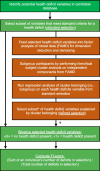Data-driven health deficit assessment improves a frailty index's prediction of current cognitive status and future conversion to dementia: results from ADNI
- PMID: 36260263
- PMCID: PMC9886733
- DOI: 10.1007/s11357-022-00669-2
Data-driven health deficit assessment improves a frailty index's prediction of current cognitive status and future conversion to dementia: results from ADNI
Abstract
Frailty is a dementia risk factor commonly measured by a frailty index (FI). The standard procedure for creating an FI requires manually selecting health deficit items and lacks criteria for selection optimization. We hypothesized that refining the item selection using data-driven assessment improves sensitivity to cognitive status and future dementia conversion, and compared the predictive value of three FIs: a standard 93-item FI was created after selecting health deficit items according to standard criteria (FIs) from the ADNI database. A refined FI (FIr) was calculated by using a subset of items, identified using factor analysis of mixed data (FAMD)-based cluster analysis. We developed both FIs for the ADNI1 cohort (n = 819). We also calculated another standard FI (FIc) developed by Canevelli and coworkers. Results were validated in an external sample by pooling ADNI2 and ADNI-GO cohorts (n = 815). Cluster analysis yielded two clusters of subjects, which significantly (pFDR < .05) differed on 26 health items, which were used to compute FIr. The data-driven subset of items included in FIr covered a range of systems and included well-known frailty components, e.g., gait alterations and low energy. In prediction analyses, FIr outperformed FIs and FIc in terms of baseline cognition and future dementia conversion in the training and validation cohorts. In conclusion, the data show that data-driven health deficit assessment improves an FI's prediction of current cognitive status and future dementia, and suggest that the standard FI procedure needs to be refined when used for dementia risk assessment purposes.
Keywords: Alzheimer’s disease; Dementia; Frailty; Frailty index; Machine learning; Mild cognitive impairment.
© 2022. The Author(s).
Conflict of interest statement
The authors declare that they have no competing interests.
Figures



References
-
- Engvig A, Wyller TB, Skovlund E, Ahmed MV, Hall TS, Rockwood K, Njaastad AM, Neerland BE. Association between clinical frailty, illness severity and post-discharge survival: a prospective cohort study of older medical inpatients in Norway. Eur Geriatr Med. 2022;13(2):453–461. doi: 10.1007/s41999-021-00555-8. - DOI - PMC - PubMed
Publication types
MeSH terms
Grants and funding
LinkOut - more resources
Full Text Sources
Medical

